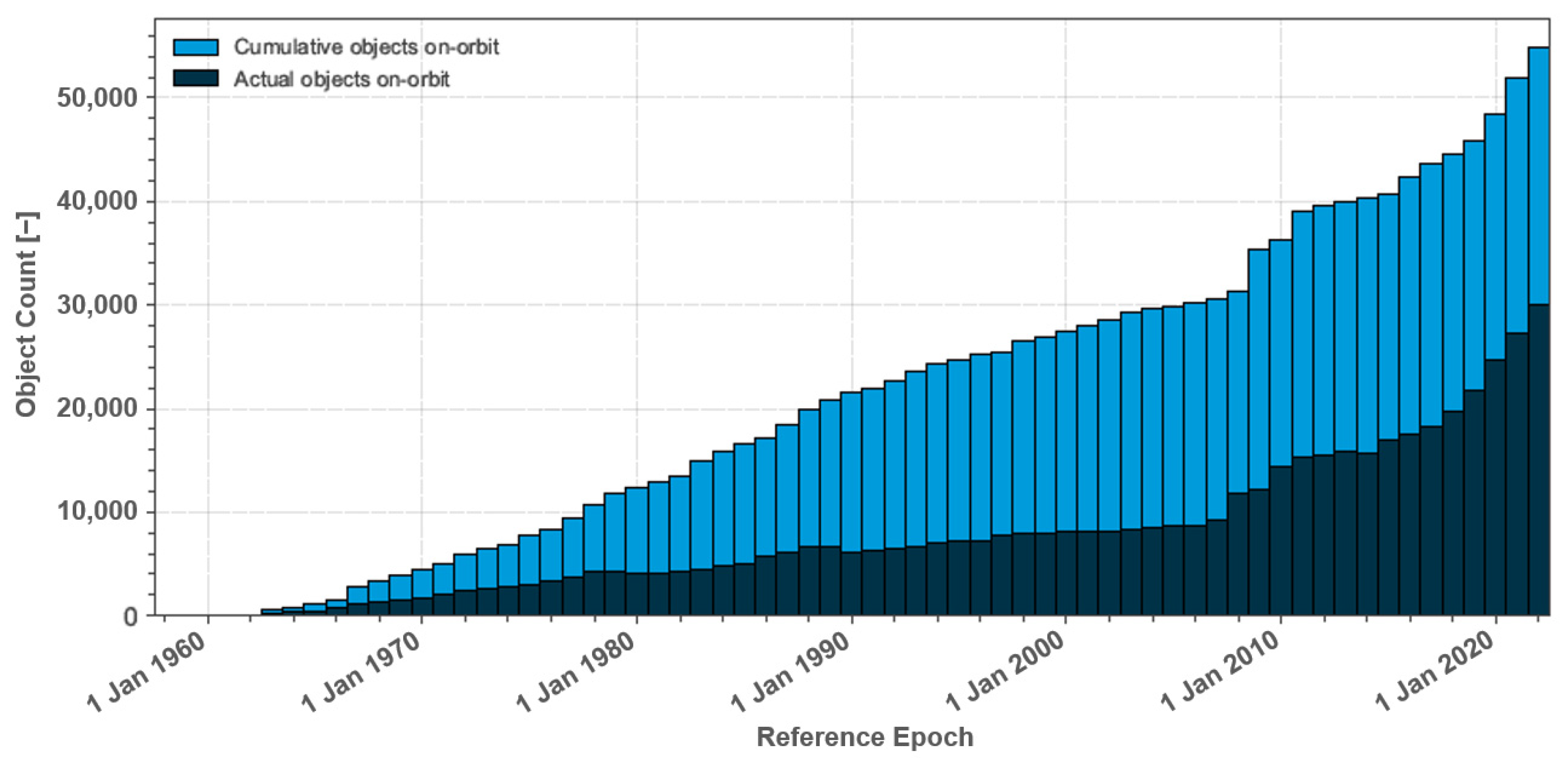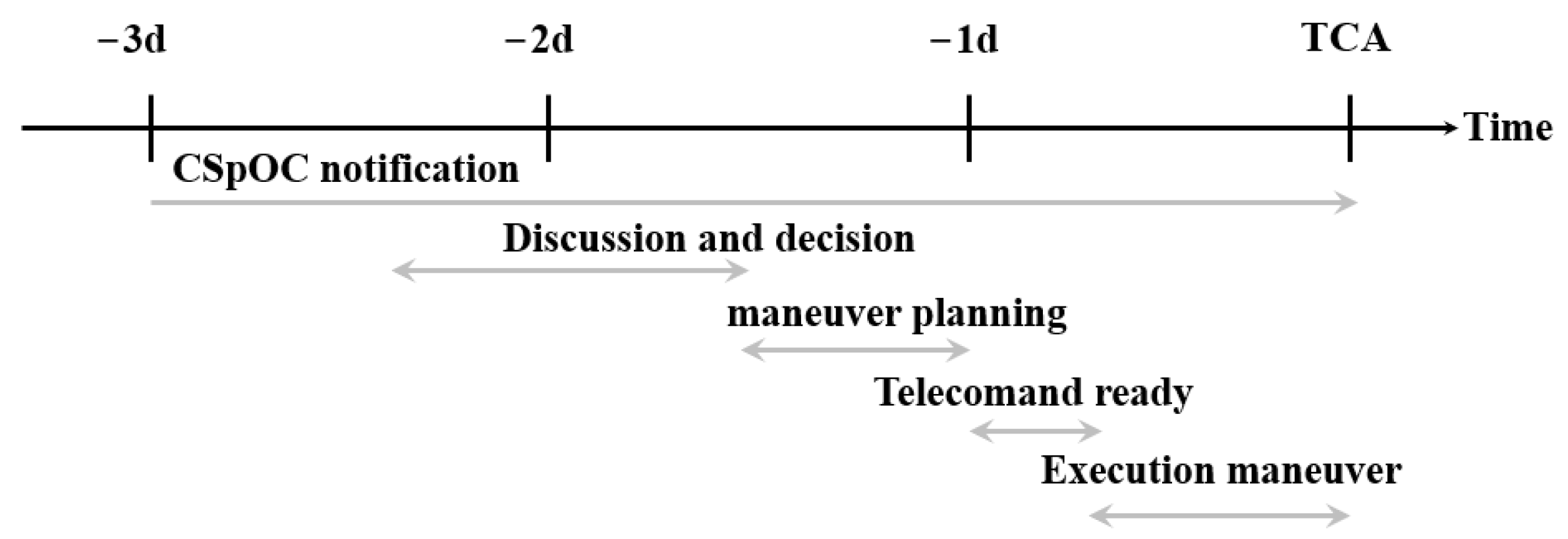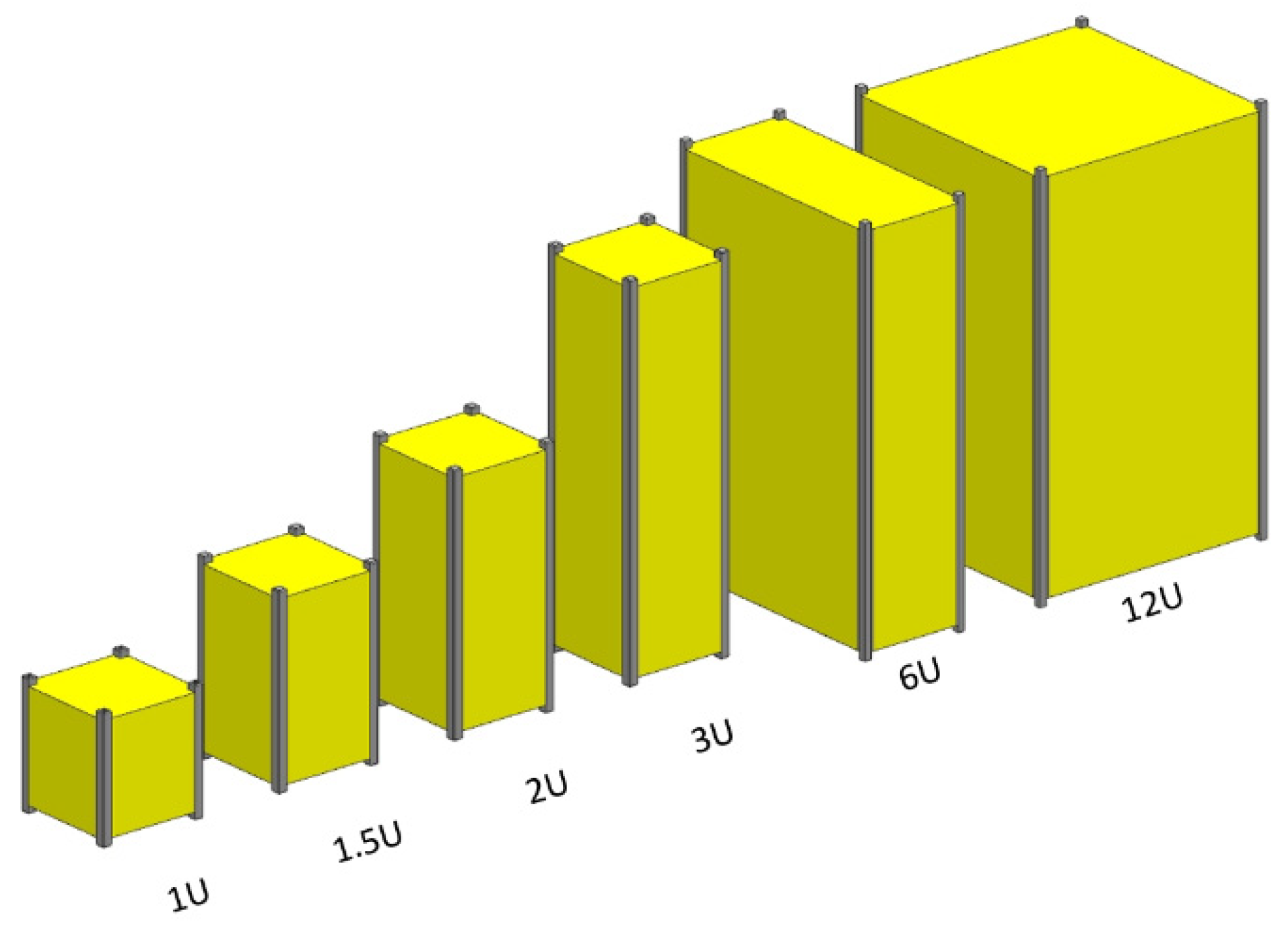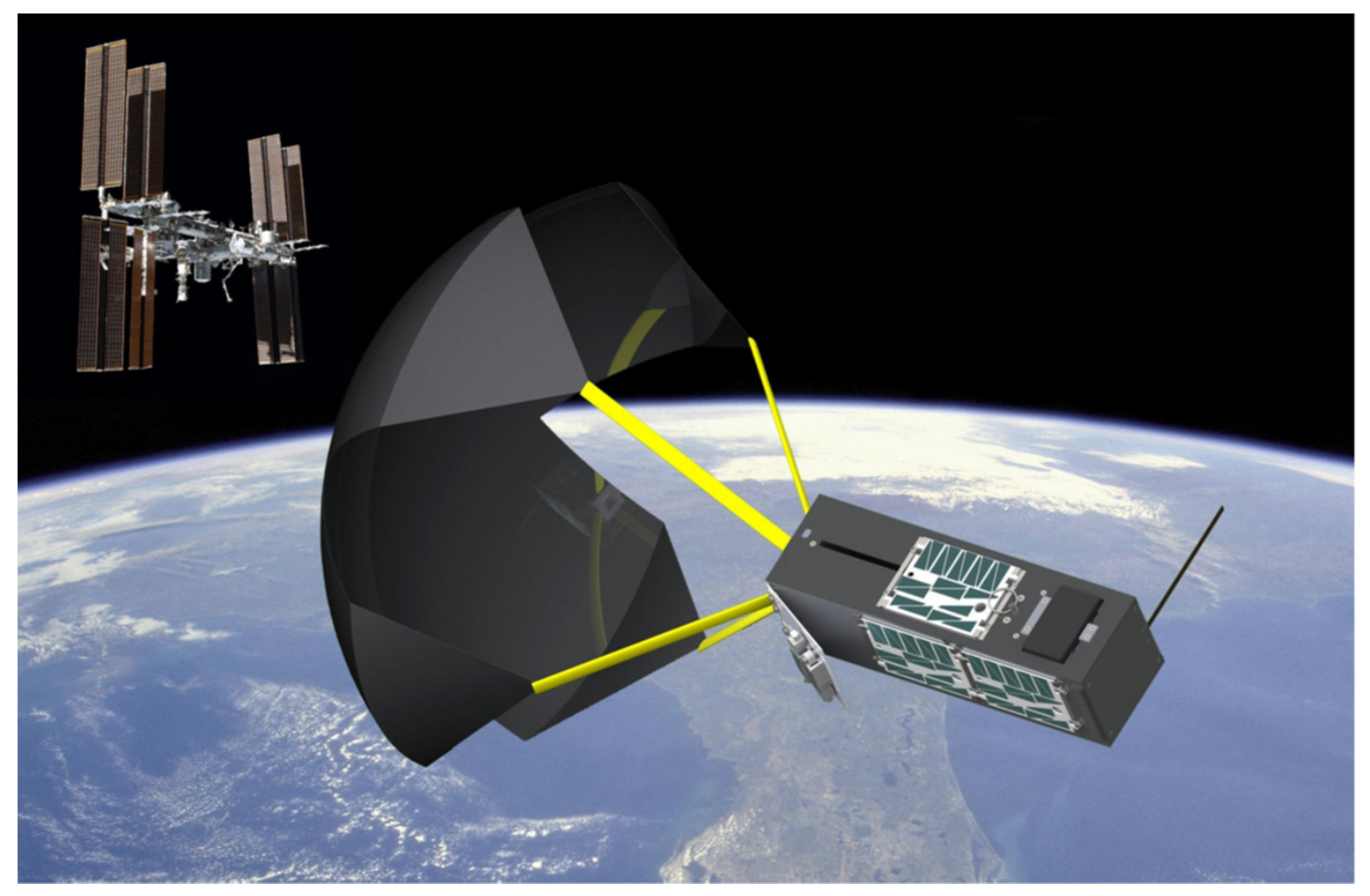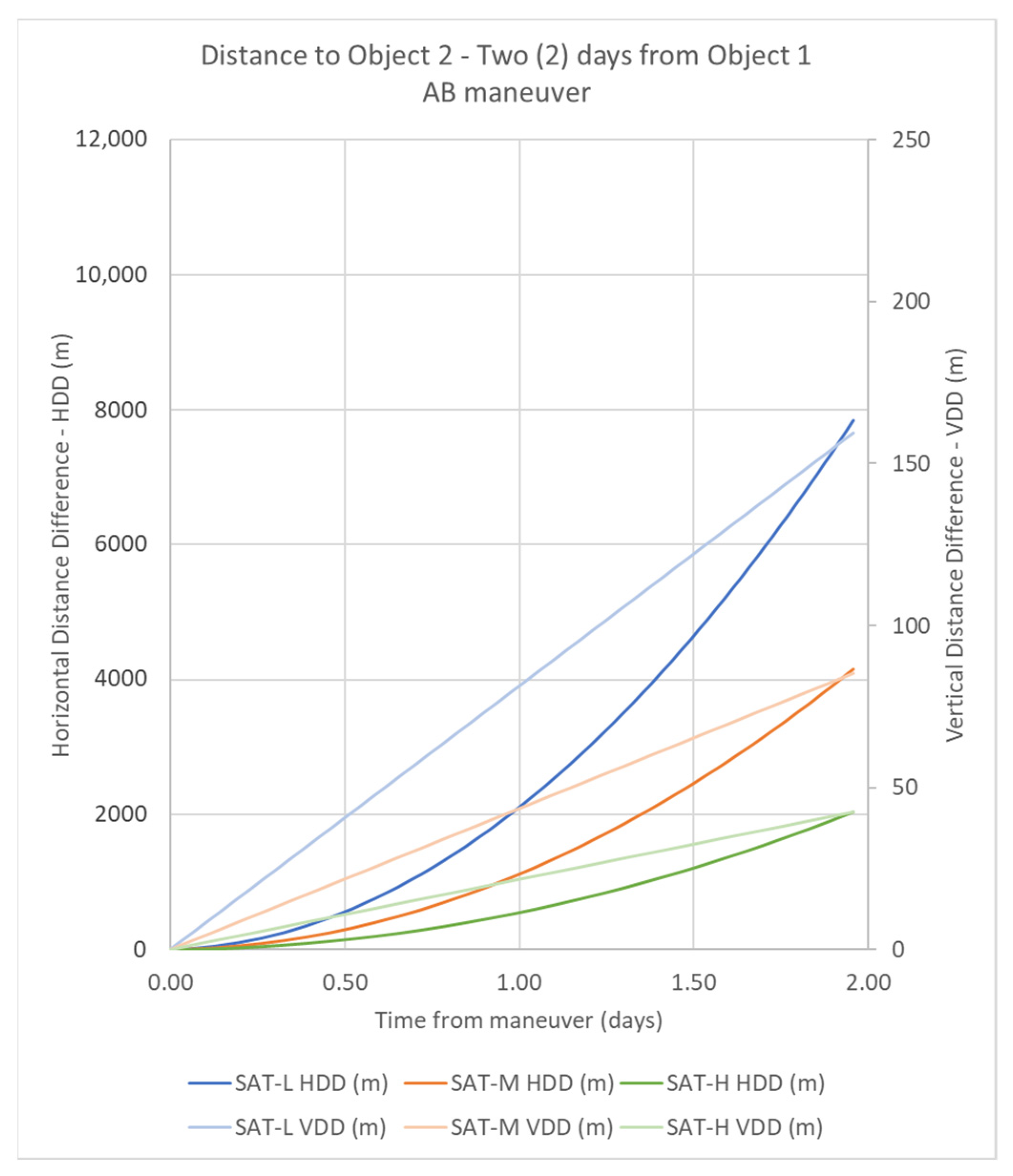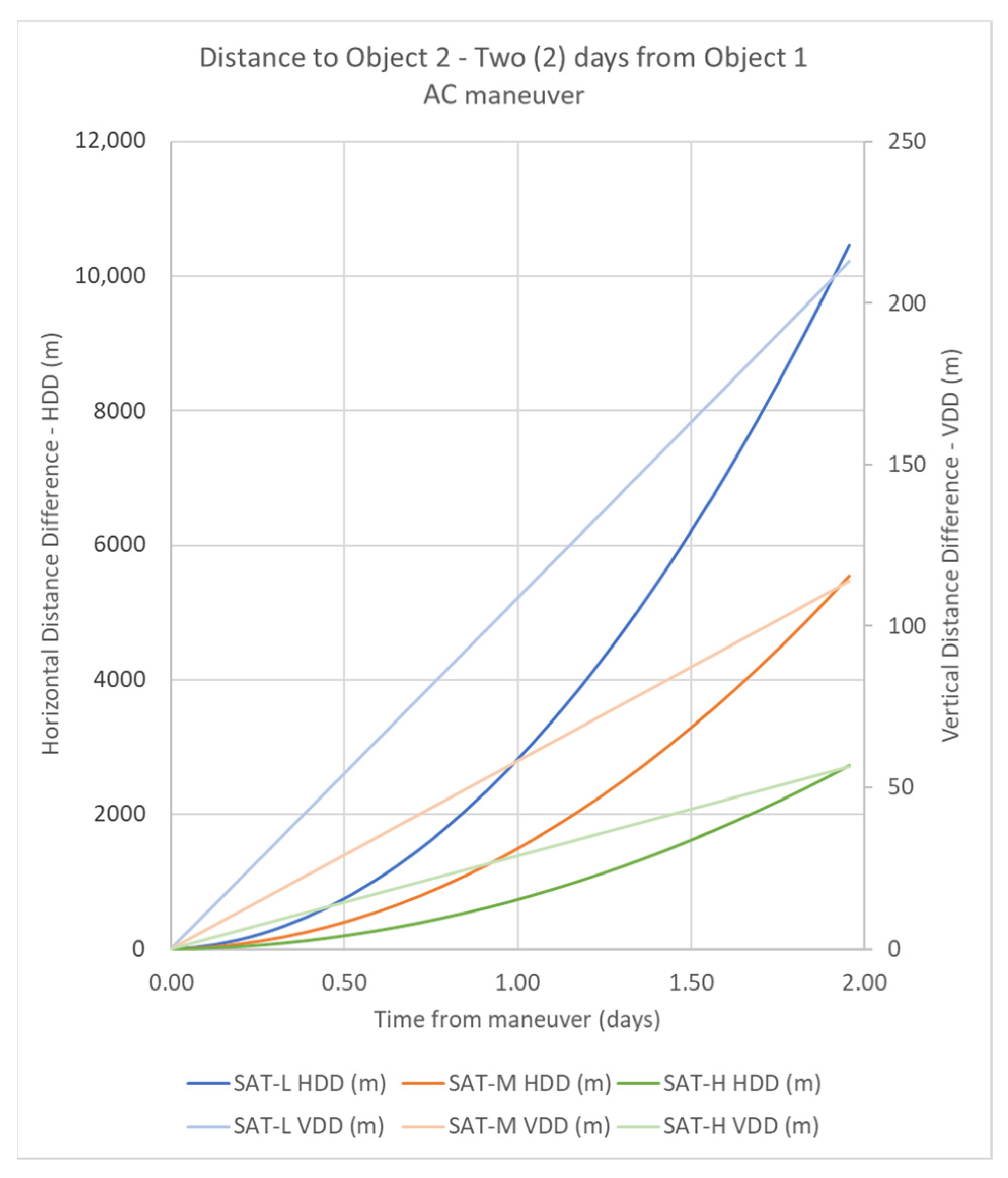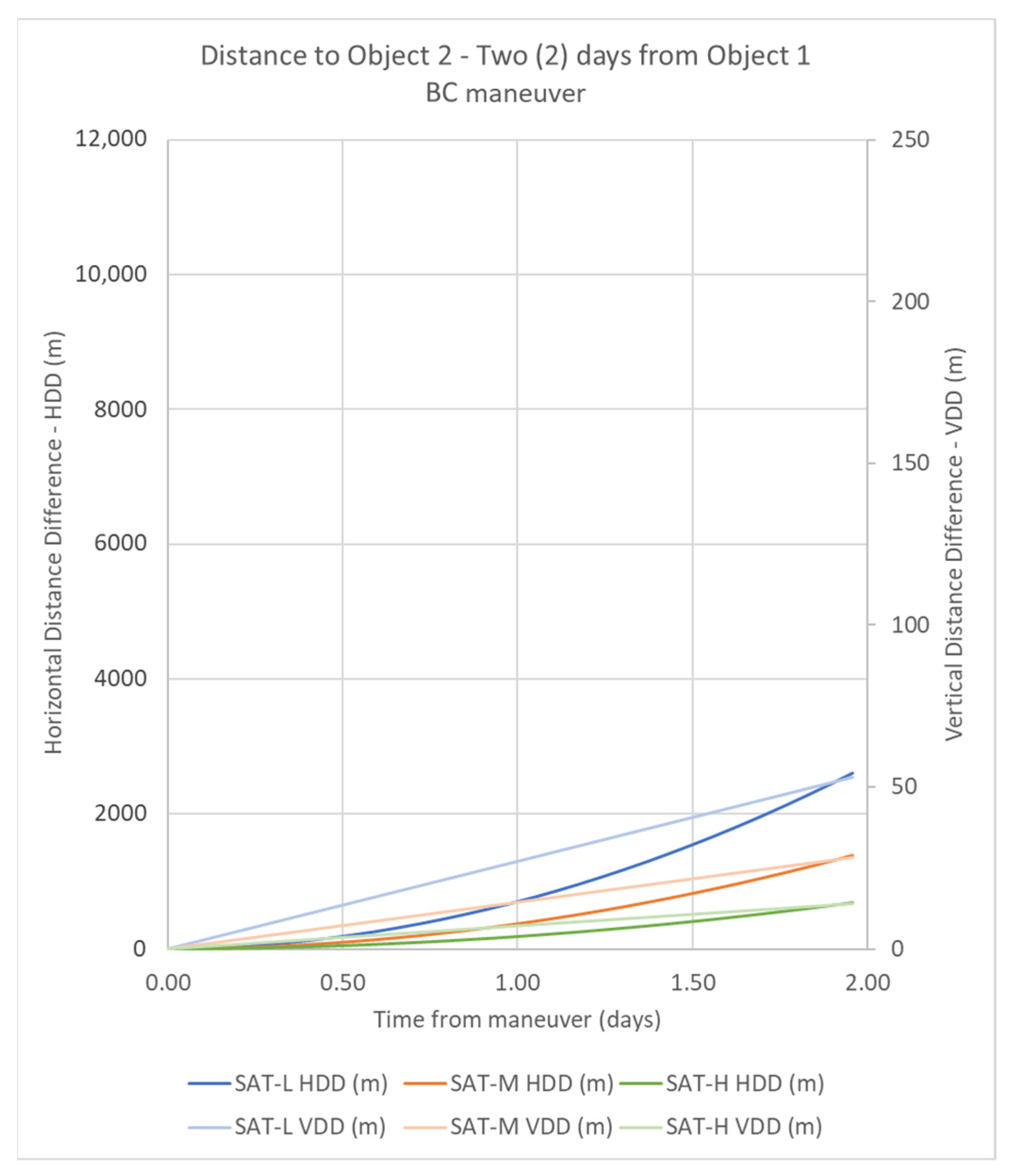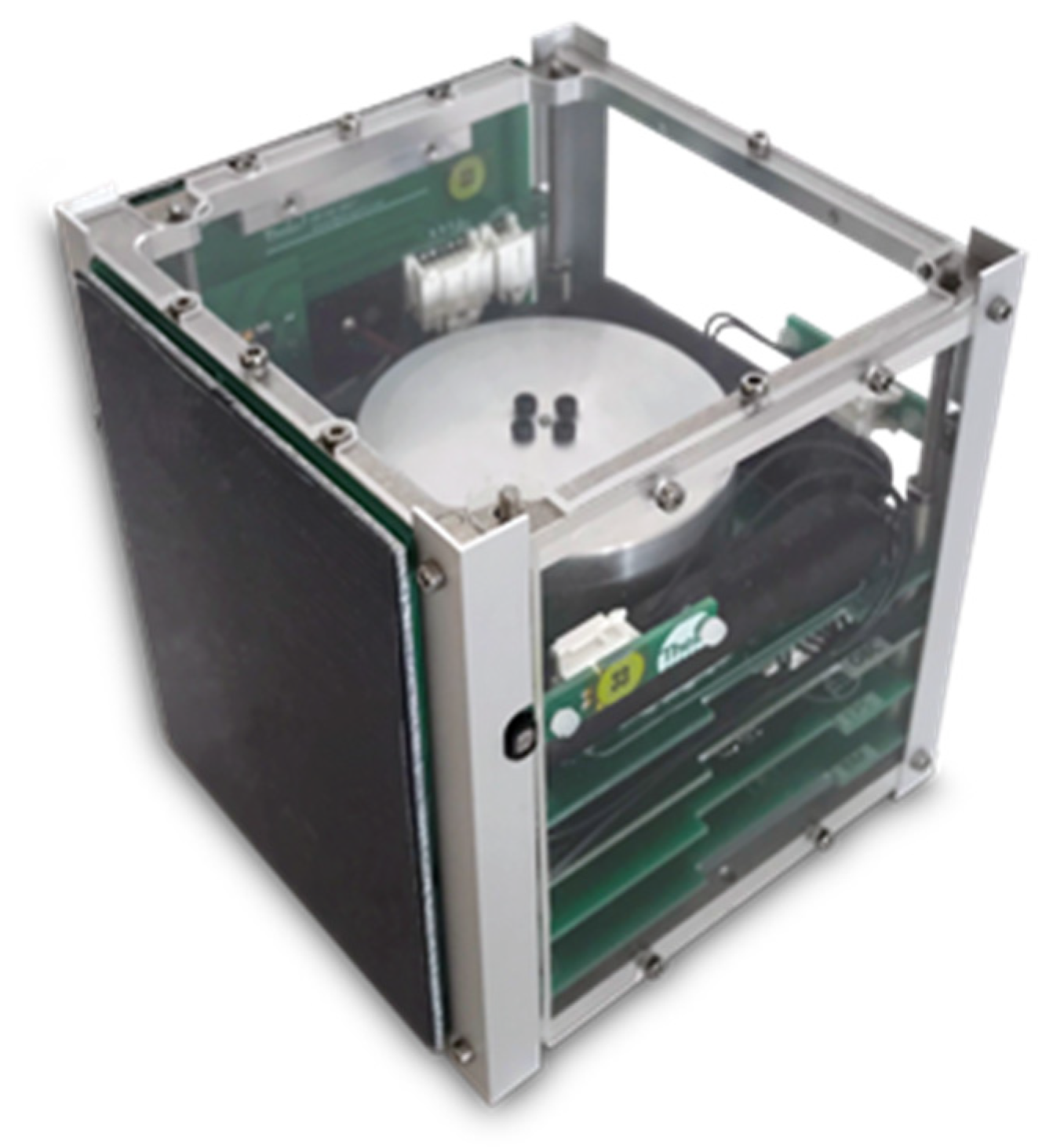3.2. ADCS System
This study explores the potential for establishing a methodology aimed at minimizing the likelihood of a collision involving a CubeSat lacking a propulsion system, solely relying on its active ADCS. The fundamental concept revolves around the idea that altering the satellite’s orientation can influence its cross-sectional area, thereby either increasing or decreasing the drag force it experiences. This adjustment in orientation is intended to occur within the time frame spanning from the initial alert period (7 days prior to the Time of Closest Approach (TCA)) to the recommended limit for maneuvers (2 days before TCA). This action will change the orbital elements of the satellite, modifying the TCA conditions in the following alerts.
To assess the potential implementation of such a methodology in CubeSats, various formats (including 2U, 3U, and 6U) are subjected to analysis. The insert orbit of Lume-1 serves as the mission scenario. Two additional altitudes are considered in this investigation: one positioned 40 km lower and another situated 80 km lower, analyzing the influence of altitude in the performance. The Lifetime tool within the STK software package is employed to model orbit propagation, considering factors such as cross-sectional area, mass, and the satellite’s initial position.
The primary objective of this part of the methodology is to ascertain the discrepancy in horizontal and vertical satellite positions within a Local Vertical/Local Horizontal (LVLH) reference frame at the TCA. This disparity is then compared against the threshold miss distances prescribed by CDMs to assess the potential utility of employing an ADCS maneuver.
Three different satellites are defined for comparison. SAT-H (semi-major axis of Lume-1 in the orbit insertion: semi-major axis of 6878 km), SAT-M (40 km lower than SAT-H: semi-major axis of 6836 km), and SAT-L (80 km lower than SAT-H, semi-major axis of 6798 km).
The drag force computation relies significantly on the cross-sectional area in the direction of velocity, also known as the drag area. This cross-sectional area varies according to the orientation of the satellite, which can be controlled by the ADCS. Specifically, 2U and 3U CubeSats can adopt two different orientations, resulting in either a 1-unit or 2-unit face area for 2U CubeSats and a 1-unit or 3-unit face area for 3U CubeSats. In contrast, 6U CubeSats offer three possible orientation options, resulting in drag areas of 2-unit face area, 3-unit face area, or 6-unit face area.
It is worth noting that CubeSats adhere to a constrained mass budget, allowing for an estimated mass of 1 kg per unit. Consequently, a 2U CubeSat will have a mass of 2 kg, a 3U CubeSat will weigh 3 kg, and a 6U CubeSat will carry a mass of 6 kg (
Table 3). Three different states, equivalent in drag force, A, B and C, can be defined considering the drag area–mass ratio. As an illustrative example, when calculating drag effects, a 6U satellite oriented with its 2-unit face aligned in the direction of velocity produces an equivalent impact to that of a 2U satellite oriented with its 1-unit face directed toward the velocity vector. This equivalence arises because the drag area-to-mass ratio remains constant in both cases.
Collision avoidance needs maneuvering, which means that the employment of the ADCS for this purpose must be expressed in terms of specific maneuvers. In the context of the satellites under examination, three distinct maneuvers are identified: for 2U satellites, a maneuver involves altering the orientation from the 1-unit face to the 2-unit face or vice versa; in the case of 3U satellites, a maneuver consists of transitioning the orientation from the 1-unit face to the 3-unit face or vice versa; and for 6U satellites, maneuvers can encompass changing the orientation from the 2-unit face to the 3-unit face or vice versa, from the 2-unit face to the 6-unit face or vice versa, and from the 3-unit face to the 6-unit face or vice versa.
These pairs of maneuvers yield similar effects but with opposing outcomes. When we increase the drag area, it leads to a reduction in the semi-major axis and the period of the osculating orbit over time, compared to the values when the orientation remains unchanged. Conversely, when we decrease the drag area, it results in a larger semi-major axis and period than what would be expected without the maneuver. Consequently, after a period of time, the satellite will be situated lower or higher than initially anticipated, giving rise to what we term the Vertical Distance Difference (VDD).
Furthermore, these maneuvers also impact the overall distance traveled by the satellites. Surprisingly, an increase in the drag area leads to an acceleration in velocity, owing to the reduced period of the osculating orbit. Consequently, the satellite covers a greater distance than expected without the maneuver. Conversely, decreasing the drag area has the opposite effect, causing a reduction in velocity and, consequently, a shorter traveled distance. This phenomenon is referred to as the Horizontal Distance Difference (HDD).
In summary, the possible maneuvers are consolidated in
Table 4, where we have three distinct maneuvers to analyze: AB, AC, and BC. In this table, the initial and final position states are shown, corresponding to a maneuver named after the combinations of both states (i.e., initial A position and final B position results in AB maneuver that can be applied to 2U and 6U CubeSats). Also, interchangeability between AB and BA maneuvers (i.e.) was considered because they would have the same effect but in opposite directions. These maneuvers exhibit intricate interactions between drag area, orbital parameters, and satellite trajectories, contributing to a comprehensive understanding of satellite behavior in collision avoidance scenarios.
The calculation of drag is conducted by utilizing the parameters incorporated within the STK Lifetime tool. This calculation encompasses both atmospheric and solar radiation drags. However, for the specific scope of this study, we focus solely on adjusting atmospheric drag parameters, while maintaining default data for solar flux pressure.
To establish a baseline for drag coefficient, a value of 2.2 is set, aligning with the typical default value for conventional satellites. While this value may appear somewhat elevated for CubeSats, it is within the same order of magnitude. The computation of atmospheric density is derived from the U.S. 1976 Standard Atmosphere model [
24], ensuring accuracy and reliability.
To account for the diverse scenarios under examination, modifications are applied to the drag area and mass, as outlined in
Table 3. These modifications serve as the foundation for the computation of drag force, including the effects of atmospheric drag force acceleration (1), which are then incorporated into the governing equations. This meticulous adjustment of parameters allows us to comprehensively analyze how variations in drag area and mass influence satellite behavior in different scenarios, contributing valuable insights to our study.
The drag integration process is executed through the Lifetime tool, employing a meticulous approach involving nine-point Gaussian quadratures per orbit. To enhance precision, we set the value of “n” to 6. This process is pivotal for determining the satellite’s lifetime, as it approximates the integration of slowly evolving orbit elements over time.
The methodology involves integrating across a single orbit to establish the rate of change for each variable. Subsequently, this rate is assumed to remain constant for a specific number of orbits during each calculation. To further elevate the accuracy of this procedure, the integration process for a single orbit is subdivided into six sub-arcs, each maintaining a constant angular measure (in true anomaly, not time). Within each of these sub-arcs, a nine-point Gaussian quadrature is employed, signifying the presence of nine sample points for precise integration.
3.3. Control Algorithm
In this section, the fundamental control mechanism that drives the evasion maneuver in CubeSats will be detailed, focusing on the use of the reaction wheel. This essential component plays a key role in the CubeSat’s ability to modify its orientation, a critical requirement for controlled ballistic coefficient change. This strategy is integrated into a holistic approach that is based on the application of the extended Kalman filter (EKF). The application of this filter allows optimizing the precision of the CubeSat state estimates, thus enabling an effective and precise evasion maneuver in the face of the threat of collisions with space debris. The CubeSat’s reaction wheel control mechanism becomes the driving force of the evasion maneuver by allowing calculated changes in the satellite’s orientation. This capability is exploited to modify the ballistic coefficient, thus contributing to slight adjustments in orbital height and, consequently, mitigating the risk of collisions. The entire process is managed in a coordinated manner using the EKF.
In applications involving linear systems with known dynamics and Gaussian noise, the Kalman filter (KF) has become the tool par excellence. Its nonlinear counterparts, namely the EKF and the unscented Kalman filter (UKF), have found applications in real-time orientation estimation in various domains, despite their challenging implementation. In an effort to circumvent the complexities associated with the linearization procedure and the challenges posed by the EKF and UKF, this study presents a two-step filter architecture designed to mitigate noise and improve filter performance. In the first phase, the information provided by the Inertial Measurement Unit (IMU) (angular acceleration) is obtained in its quaternion form; this quaternion is then utilized as state vector in the KF, in order to determine the corresponding observation vector. With this precise value of the attitude of the spacecraft, the control law is applied to a linear quadratic regulator that implements the orientation control of the CubeSat to implement the collision avoidance maneuver.
The quaternion can be defined as:
And, therefore, the Yaw Euler angle can be found as:
The next step is to create the dynamic model in discrete time, rebuilding the signal using the attitude information obtained through the IMU, solving the uncertainty that comes from the noise in the measurement and the common bias that those reads come with. The dynamic equation that describes the attitude of the CubeSat can be written as:
where
ω is the angular velocity,
I is the velocity tensor, and
is the resultant of the torques that the spacecraft is suffering, including the reaction wheel action and the perturbations.
Written in quaternion form, and discretizing the previous equation, we can rewrite the equations as:
And the required dynamics that the spacecraft is demanded can be written as [
24]:
We can now introduce the Quaternion Estimator to build the reconstruction of the attitude using the sensors in the IMU of the CubeSat, to provide the input for the KF. The idea is to minimize a cost function as:
where
represents the normalized body-frame vectors that represent the
j measurements,
is the corresponding inertial ones, and
sj is the level of confidence for each of the measurements [
25]. If we now define the observation vectors as:
We can then introduce the attitude profile matrix:
So that we can finally obtain:
where
is a scalar and
y is a vector given by:
Having the Davenport matrix as:
where:
Having I as the identity matrix, C the sum of the L matrix and its transpose, and is the greatest characteristic of the Davenport matrix.
Now that the reconstruction step has been performed, the next phase will filter the uncertainties of the attitude estimated using an EKF. The EKF is an analytical method employed for the estimation of attitude in dynamic systems, leveraging both prior knowledge of the attitude and real-time sensor measurements to calculate the current attitude of the system. EKF has been chosen because of its ability to handle nonlinear systems by linearizing the differential equations that describe the system’s dynamics, addressing KF limitations by introducing a linearization step. By the use of linearization of the nonlinear equations (between the system’s attitude parameters and the sensor measurements) around the current estimated state, it will enable the application of standard Kalman filter techniques, providing accurate estimates even in the presence of nonlinear dynamics. The EKF will iteratively update its estimates, combining the information from both the prediction based on the system’s dynamics and the correction based on the actual sensor measurements, refining the attitude estimates over time.
Define the expected measurement on the predicted state
as:
where
is a non-linear differential function and
is the measurement noise. And, having:
where
is a non-linear differential function and
is the process noise.
The state model serves to forecast the subsequent state of a dynamic system based on the current state, while the measurement model anticipates the observation vector using the projected state. In the context of the EKF, the linearization process is applied around an estimated orientation that undergoes continuous updates through sensor observations. At each iteration, the EKF undertakes the process of linearization of the differential equations. This involves approximating the nonlinear relationships between system variables by their linear counterparts, allowing the EKF to iteratively update predictions and measurements with improved accuracy as it refines its estimation of the system’s state over time.
The filter uses the first initial state , as the state covariance matrix, as the measurements given by the IMU, as the process noise covariance matrix, and as the measurement noise covariance matrix.
The maximum number of iterations of the process, denoted as N, is a parameter in the EKF that may be contingent on the specified error threshold or defined by the system designer. It is worth noting that all input parameters, excluding sensor measurements, were initialized based on certain assumptions, as in common scenarios where covariance data are unavailable. The EKF algorithm can be conceptually divided into two primary steps: prediction and measurement update.
During the prediction step, the algorithm forecasts the state using the past state (
) and the linearized function
F (the Jacobian matrix of
) to find
:
And, simultaneously, the state covariance matrix
P is predicted based on
F.
Subsequently, in the measurement update step, the differential equation of the measurement model is linearized by computing the Jacobian matrix
, to find
. This linearization is crucial for calculating the measurement prediction and determining the Kalman gain (
K), given as:
The Kalman gain, along with the sensor measurements and the expected measurement based on the predicted state (
y) is then employed to update the predicted state vector:
Furthermore, the state covariance matrix undergoes an update using the gain (K) and the linearized observation matrix (H). The optimal estimate, denoted as x_k, represents the output of the filter and serves as the refined estimation of the system’s current state. This iterative process continues until the maximum number of iterations is reached, as determined by either the specified error threshold or the designer’s predetermined limit. The inclusion of the prediction and measurement update steps, along with the iterative nature of the algorithm, enables the EKF to continually refine its estimates, providing an optimal and accurate representation of the system’s evolving state over time.
